Malaysian Claypot Chicken Rice (without the claypot … or the chicken)
Malaysian claypot chicken rice is traditionally cooked in a claypot, as the name obviously suggests. But I’ve adapted it for a rice cooker and brown rice for a simple and nutritious turn-the-rice-cooker-on-and-walk-away dinner that you’ll keep coming back to. And I even have a vegan variation for you.
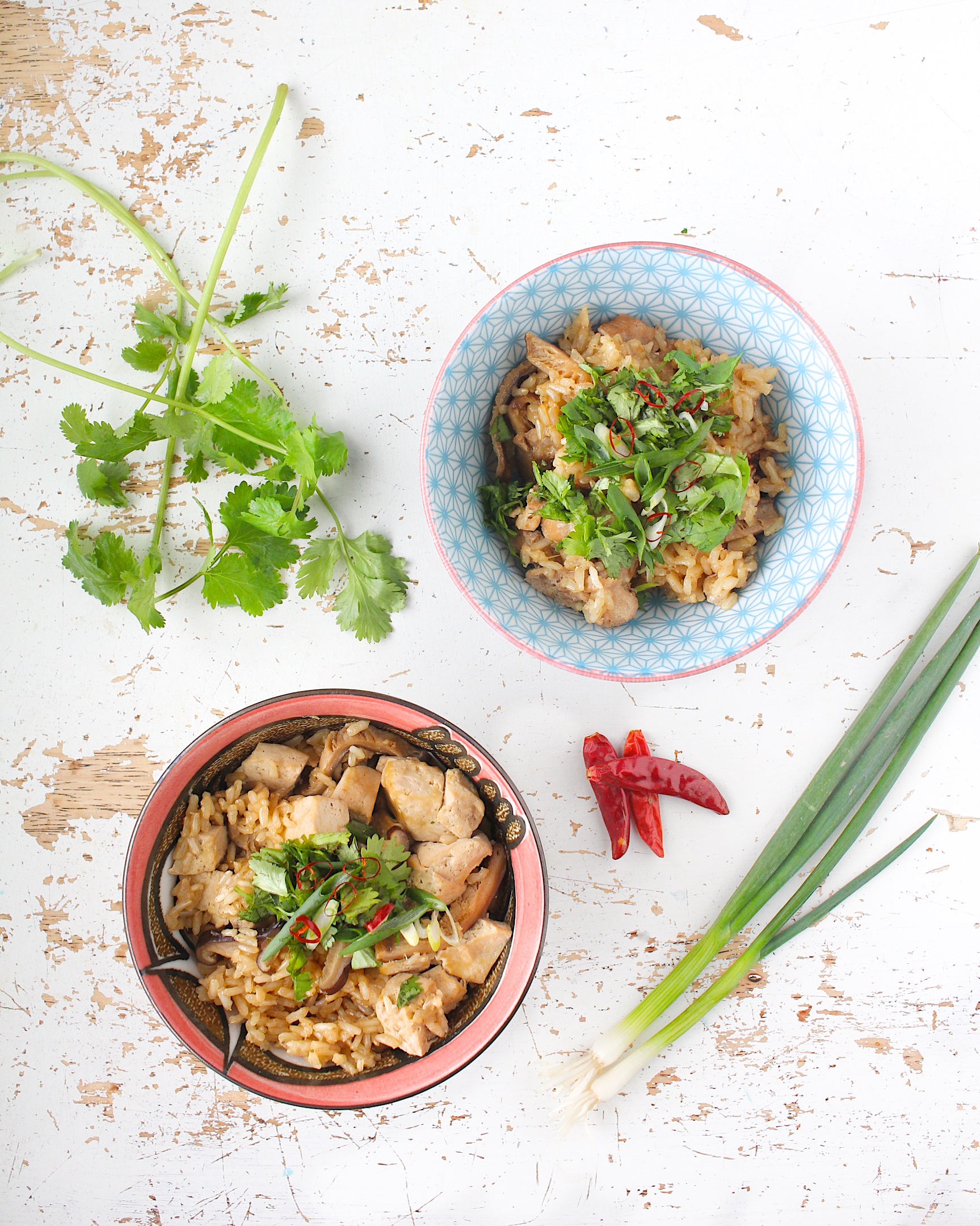
I know, I know, it has chicken in the title and I’m categorizing it under “vegan”. So let me really quickly clarify by saying it’s definitely a chicken dish, but it’s so easily adaptable (with a tiny bit of help) to tofu that it was worth claiming the vegan-ness of it. The tofu version is so flavorful, you won’t be missing the chicken. I alternate between the two recipes when I make it for my family.
And you guys, this dinner. It’s amazing. It’s so unbelievably easy and the flavor is so innnnntensely good that I can’t believe I’ve lived without it for so long. The problem was that it wasn’t convenient. Hovering over the stove, tinkering with the temperature, crossing my fingers that it doesn’t burn or overcook, adding the chicken at just the right time. And don’t get me wrong, I don’t really do convenient foods, but I live in real life, too, and I need to get dinner on the table during hangry hour just like everyone else. And some days, the process isn’t as fun for me as others. (i.e. whiny kids, screaming baby, school work, homework, all the noise, noise, noise, noise!) So I needed an easy solution for this meal I wanted more of in my life.
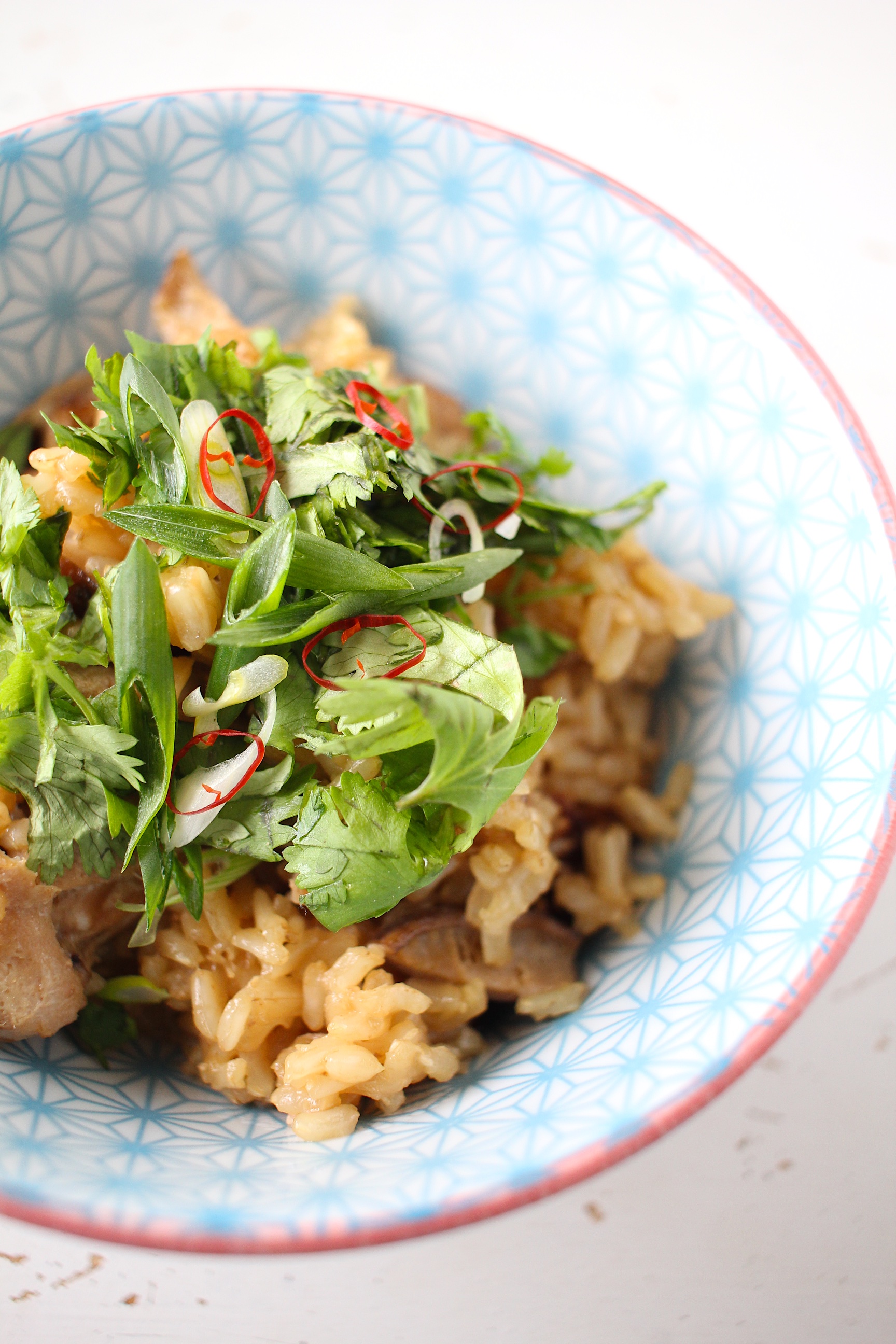
It’s actually really similar to Japanese mixed rice dishes, so it only made sense to me to try adapting it for the rice cooker. And guess what, it worked beautifully. The key was to use chicken thighs instead of breasts because chicken breasts dry out too fast and thighs remain tender and practically melt in your mouth even when cooked this long. This eliminated the guessing game of when to add it to the pot, hoping I timed it all right. I could just measure out the rice and water then add the mushrooms and marinated chicken over the top and turn on my machine.
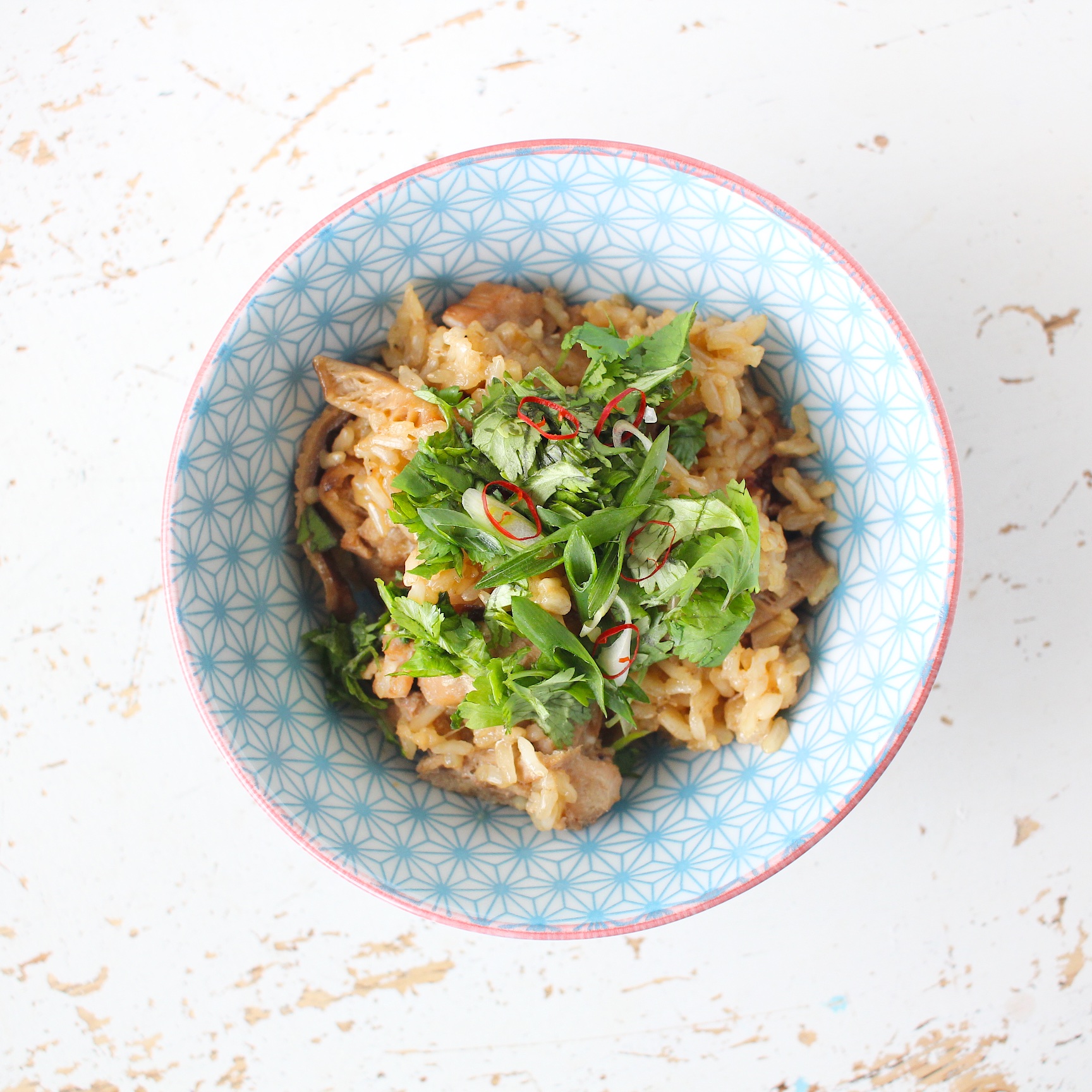
If you don’t have a rice cooker, don’t fret. You can still do it in a pot. You’ll want to keep an eye on it so it doesn’t burn, Just follow the instructions but put it all in a large enough pot to hold everything. Better yet, use a claypot if you have one! Bring it all to a boil, the drop to a simmer and let cook for 45 minutes to an hour, when the rice is cooked through and tender.
Oh, and speaking of burning, when you scoop the bottom rice out of the pot and see dark, sticky, saucy rice, don’t panic. That’s called okoge in Japanese and it’s the best part. It’s all of the caramelized sauce that settled at the bottom and … well, I serve myself last for a reason other than selflessness. But that precious okoge is another reason that if you don’t use a rice cooker (which is designed to cook rice perfectly every time), you want to keep a close eye not to burn it. You do not want to waste that flavor-packed amazingness on the bottom.
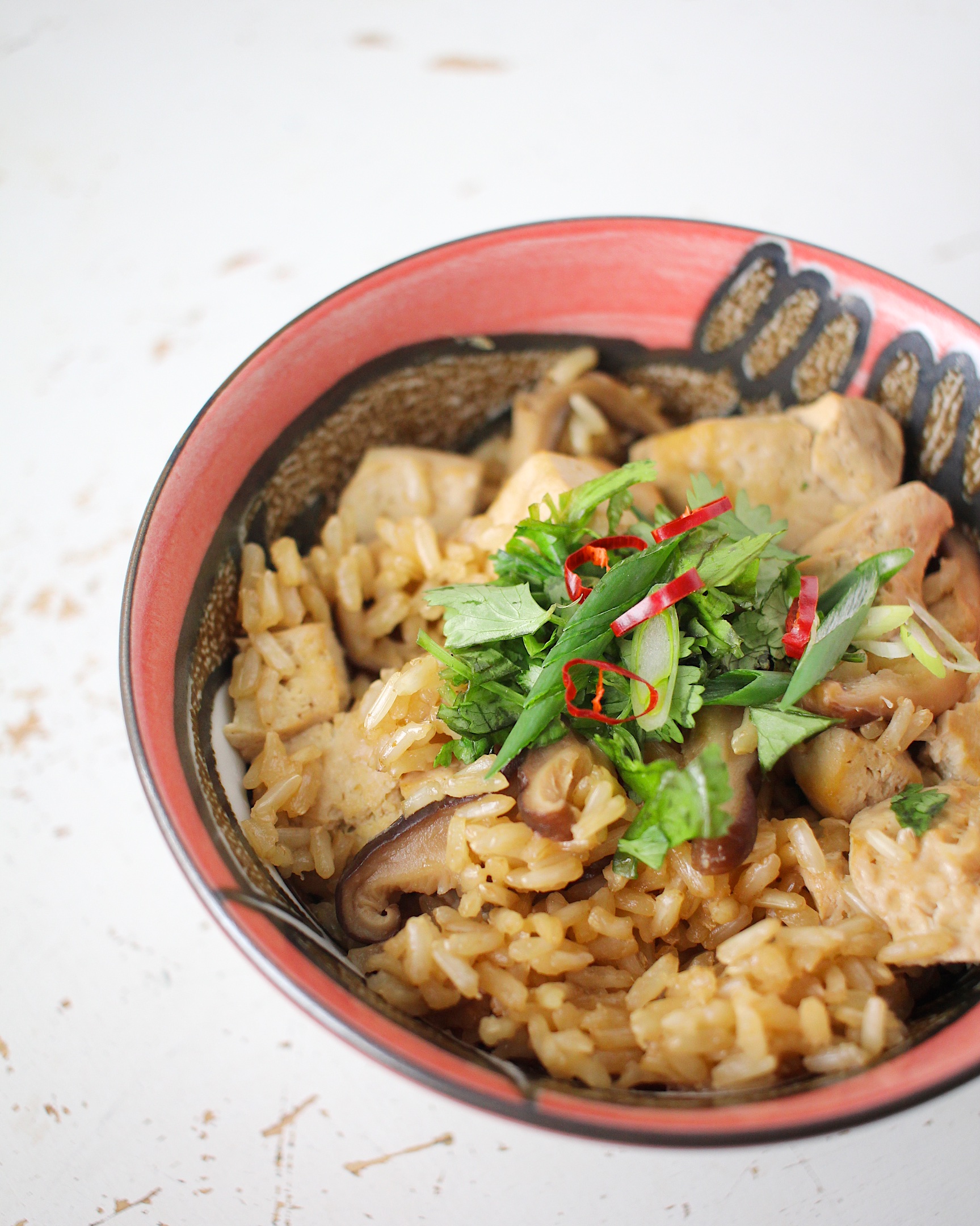
Let’s talk about the vegan version for a second here. As you’d expect, tofu doesn’t have as much flavor to impart to the overall dish as chicken. And I refuse to have my meatless dishes feel like a poor man’s version of the “real thing”. Thankfully, the marinade is like a double punch of aromatic-heaven to begin with, so I had a great start to work up from. I made a few small adjustments to the marinade and made sure to let it all soak for a little longer than the chicken required. It’s worth the extra patience, I promise. The flavor is different, of course, but not at all subpar. This tofu version really deserves it’s own separate post, come to think of it.
As always, I suggest soaking the rice overnight or up to 24 hours prior to cooking to remove phytic acid for proper nutrient absorption. So go gather your ingredients now and prep to make it for Sunday dinner!


- 2.25 cups (3 rice cooker cups) long grain brown rice, preferably organic
- 3 cups water, preferably dechlorinated (for soaking)
- 1/3 cup acidic medium (fresh lemon/lime juice or raw apple cider vinegar) or fermenting liquid
- approximately 2.25 cups water, preferably dechlorinated (for cooking)
- 1 lb chicken thighs, cut into 2 inch pieces
- 5 dried shiitake mushroom caps
- 2 tablespoons grated ginger
- 1/4 cup soy sauce*, preferably organic
- 1 tablespoon honey or pure maple syrup
- 1 teaspoon fine sea salt
- 1/2 teaspoon freshly ground black pepper
- 1 tablespoon sesame oil
- cilantro, roughly chopped
- green onions, thinly sliced
- bird eye chillies (fresh or dried), thinly sliced (optional)
- Combine the rice, soaking water, and acidic medium or fermenting liquid in a medium bowl and let soak over night or up to 24 hours. Drain and rinse thoroughly.
- About half an hour before you're ready to cook the rice, submerge the mushroom caps in warm water to soak. Once soft and pliable, about 15~20 minutes, squeeze excess water out and slice thinly. Set aside and reserve the soaking water.
- In a medium bowl combine the ginger, soy sauce, honey or maple syrup, salt, pepper, and sesame oil and whisk to combine. Add the chicken and toss to coat. Let the chicken marinate for 15~30 minutes.
- Add the soaked and rinsed rice in the bowl of a 5 cup or larger capacity rice cooker. Add the reserved mushroom soaking water. Then add enough water to go to the 3 cup mark, approximately 2.25 cups. Add the mushroom slices over the top and then the chicken and all of the marinade. Turn the rice cooker on to cook. If you have a brown rice setting, use that.
- Once the rice cooker is done cooking, let the rice rest for a few minutes before opening. Serve with cilantro, green onions, and chillies.
- *make sure to use certified gluten-free soy sauce or tamari if serving someone with gluten-free needs as soy sauce traditionally contains wheat.


- 2.25 cups (3 rice cooker cups) long grain brown rice, preferably organic
- 3 cups water, preferably dechlorinated (for soaking)
- 1/3 cup acidic medium (fresh lemon/lime juice or raw apple cider vinegar) or fermenting liquid
- approximately 2.25 cups water, preferably dechlorinated (for cooking)
- 1 lb extra firm tofu, pressed and cut into 1 inch cubes*, preferably organic
- 5 dried shiitake mushroom caps
- 2 tablespoons grated ginger
- 2 green onions, minced
- 1 large clove or 2 small cloves of garlic, grated
- 1/4 cup soy sauce**, preferably organic
- 2 tablespoons pure maple syrup
- 1 teaspoon fine sea salt
- 1/2 teaspoon freshly ground black pepper
- 2 tablespoons sesame oil
- cilantro, roughly chopped
- green onions, thinly sliced
- bird eye chillies (fresh or dried), thinly sliced (optional)
- Combine the rice, soaking water, and acidic medium or fermenting liquid in a medium bowl and let soak over night or up to 24 hours. Drain and rinse thoroughly.
- 1 to 4 hours before you are ready to cook the rice, combine the ginger, green onions, garlic, soy sauce, maple syrup, salt, pepper, and sesame oil in a medium bowl and whisk to combine. Add the tofu and toss to coat. Let the tofu marinate for 1 hour or up to 4 hours, tossing occasionaly to redistribute the marinade.
- Meanwhile, submerge the mushroom caps in warm water to soak. Once soft and pliable, about 15~20 minutes, squeeze excess water out and slice thinly. Set aside and reserve the soaking water.
- Add the soaked and rinsed rice in the bowl of a 5 cup or larger capacity rice cooker. Add the reserved mushroom soaking water. Then add enough water to go to the 3 cup mark, approximately 2.25 cups. Add the mushroom slices over the top and then the tofu and all of the marinade. Turn the rice cooker on to cook. If you have a brown rice setting, use that.
- Once the rice cooker is done cooking, let the rice rest for a few minutes before opening. Serve with cilantro, green onions, and chillies.
- *To press the tofu, lay on flat on a cutting board with a clean kitchen towel underneath. Add another clean kitchen towel on top, then another cutting board or plate, and something stable and heavy like a can of tomatoes. Press for 10~15 minutes to get rid of excess water.
- **make sure to use certified gluten-free soy sauce or tamari if serving someone with gluten-free needs as soy sauce traditionally contains wheat.


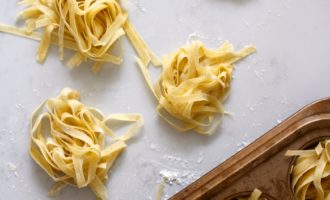
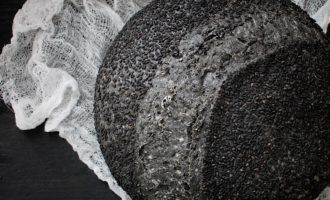
Be the first to comment.